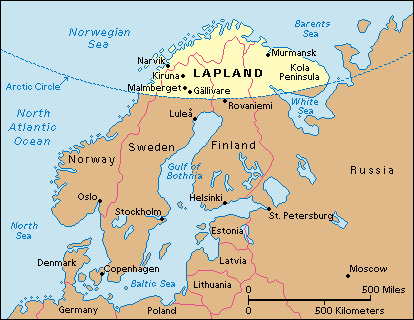Lapland is the northernmost region of Europe. It covers the far northern parts of Norway, Sweden, and Finland, and the Kola Peninsula of Russia. Lapland has no definite boundary to the south, but it ends approximately at the Arctic Circle. It covers about 150,000 square miles (388,000 square kilometers).

Lapland got its name from its native people, whom outsiders used to call Lapps. The Sami, as they prefer to be known, have lived in Scandinavia for thousands of years. They call their territory Sapmi (also written as Sápmi). Sapmi includes all of Lapland and extends south of the Arctic Circle through the mountains of Norway and Sweden to about 62° north latitude.
Winter in Lapland lasts from October to May. During winter, lakes and rivers are frozen, and the land is covered with snow. Winter temperatures fall as low as 0 °F (–18 °C) at the coast and –60 °F (–51 °C) inland. In summer, temperatures rise as high as 70 °F (21 °C) at the coast and 80 °F (27 °C) inland. Because Lapland lies so far north, it has a period of two months in summer when the sky never darkens. On the other hand, the sun never rises above the horizon for two months in winter.
Most of Lapland is a bleak, barren region with stunted trees and thin vegetation. However, some areas have extensive forests of birch, pine, and spruce. The cold climate limits the growth of most trees. Other plant life includes shrubs and berry bushes. Mosses and lichens are an important food for the region’s reindeer.
Iron ore and nickel are Lapland’s most valuable mineral resources. Beds of iron ore lie beneath the soil of southern Swedish Lapland. The Russian part of the region has nickel deposits. Lapland’s iron ore deposits rank among the world’s largest.
